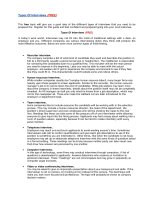11 types of content you should be creating for SEO right now
Bạn đang xem bản rút gọn của tài liệu. Xem và tải ngay bản đầy đủ của tài liệu tại đây (6.05 MB, 24 trang )
11 TYPES OF
CONTENT
YOU SHOULD BE
CREATING
FOR SEO
RIGHT NOW
Simple Ideas to Help Kick
YOUR CONTENT MARKETING STRATEGY INTO HIGH GEAR
A white paper for business owners or anyone who wants
to learn how to make content work to their SEO benefit.
table of contents
3
Executive Summary
Blog
3
4
Make your blog the home base for your entire content
marketing strategy.
4
Images
Strategically distribute images to drive relevant
traffic to your site.
6
Videos
6
Set yourself apart from the competition with highquality, affordable video production.
8
Podcasts
Reach niche audiences with informative, entertaining,
downloadable content.
9
SlideShare Presentations
Bring compelling slideshows about your company to
almost every online outlet.
11
Newsletter and Email
Put targeted emails and newsletters right in
prospects’ inboxes.
13
@
11
Online Surveys
Gather valuable customer data and attract site
visitors at the same time.
15
9
8
White Papers
13
15
17
19
Engage your audience with deep, substantive and
actionable content.
17
Infographics
Attract links and traffic through elegant and
entertaining data visualizations.
19
Online Tools
Develop simple web applications that solve problems
for customers.
20
Case Studies
Showcase your successes to generate sales leads.
21
22
Summary
About SEO.com
20
executive summary
Getting in front of the right audience is one of
the biggest marketing challenges any business
will face, especially given the fractured media
landscape and niche communities that people
inhabit online. The role of search engine
optimization is to marry comprehensive market
research and best practices to target those
diverse communities and funnel them back to
your website.
The days when their customers were neatly
funneled into just print, radio and TV are long gone,
and yet some firms still treat those channels as
the basis of their marketing. Those media are
costly to advertise in and their power to reach
a diverse audience is diminished in many ways,
especially in younger age demographics.
Each section of this paper lays out the specific
benefits of different types of content, plus some
tips for using them successfully. A lot of these
are a good starting point for fledgling marketing
efforts, while others are probably better to
try as your content marketing matures or you
decide to invest in more resources and talent.
These are all proven methods for connecting
with your audience and raising your visibility in
search results for your most valuable keyword
searches. Generating engaging content that
makes sense given your industry and your
audience is a smart SEO strategy for the long
term. Next, we’ll explain how.
Paul Sanders is a Content
Strategist with SEO.com.
He helps strategize and
develop material for
clients’ SEO and content
marketing campaigns.
He also develops best
practices and training for
some of SEO.com’s other
content strategists.
Share this eBook!
In this paper, you’ll learn about:
• Blogs
• Images
• Video
• Podcasts
• SlideShare Presentations
• Newsletters & Email
• Online Polls & Surveys
• Whitepapers
• Online Tools
• Case Studies
But even as available marketing channels have
multiplied, so has the number of powerful tools
allowing companies to connect with their current
and potential customers. To make your marketing
strategy work, a company needs to find marketing
vehicles that engage potential customers. A
variety of sensible content vehicles to fuel that
engagement is essential to any online marketing
effort because content is the core of good SEO
practice.
This white paper highlights 10 of the most
successful types of content that savvy companies
are using to drive traffic to their websites, build
online communities and establish themselves as
thought leaders in their industries.
Highly relevant, keyword-rich content that engages
readers has tremendous value in any serious SEO
strategy. Search engines like Google and Bing are
not just looking at the content on your site and the
keywords that it contains; the algorithms they use
to rank websites consider user interaction, social
sharing and natural linking patterns that occur
only around really good content. The better your
content, the more engagement it will generate,
the more activity search engines will notice on
and around your site, and the better your search
rankings will be.
blog
One of the smartest places to start with content marketing is with a blog because , well, words are
cheap. Publishing just a few blog posts a week takes very few resources or specialized technical skills. If
your web developer can set up a simple WordPress blog (the popular, free blogging software platform),
you can be up and publishing on your existing website in short order.
TIPS FOR IMPLEMENTING
YOUR COMPANY BLOG
There are right and wrong ways to manage a blog and the
content that goes on it. These tips should help you get
started on the right foot:
1
Keep a regular blog schedule, at least three times per week.
Ideally, you want to post multiple times per day. If people keep
coming back to your site, and don’t see new content, pretty
soon they’ll stop coming back. Content freshness also has
implications for your site’s SEO efforts. Frequent updates
mark you as more relevant than competitors.
2
Maintain a high level of quality and relevance to your readers.
Bad, boring and off-topic writing will not help you reach the
right people; data-rich, well-researched posts by industry
experts at your company will.
3
Place your blog on the same web domain as your main site
(e.g., or on a sub-domain (e.g.,
). Having it on a separate domain
only separates the branding value and search relevance that
you build up there from your main site.
4
Implement a comment management system (like Disqus)
that allows users to sign in and comment with their
Facebook, Google+ or any number of other social platform
accounts. A management system will also help you to combat
spam and moderate discussions that your posts generate.
5
Make your blog imminently shareable by including social
share buttons on every post. Let people to spread content
they like with just a few clicks.
Your blog, like the rest of your content strategy, will evolve over time.
People who write for your blog will become better writers with time,
and your audience will grow. And if you are writing on topics that people
respond to, you’ll start to drive traffic to your blog and the web properties
to which it points.
Once your blog gains some maturity, it will become a significant channel
through which you communicate with customers, the press and your
industry at large. Concerted effort here can reap dividends later on in
search-engine visibility, brand authority and growing web traffic.
3
Most of the content on this list could be accessed
through your blog, or at least linked to from it. It’s
the perfect home base from which to execute the
rest of your content marketing initiatives. A blog
is also the logical place where return visitors will
check for news on your products and services, or
just to find more great content.
Write relevant articles that attract readers and
help build your site’s relevance for search engines,
and then direct those readers to the pages on
your site that are optimized for conversion.
People may link to relevant articles as well, which
is a good
signal to
search
engines
that your
site is an
authority.
( />
PRO TIP: Don’t just link back to your own site
or other blog posts; link to relevant sites all
over the Web to help your audience identify
your blog as a nexus of curated resources.
What’s more, many company websites suffer from
a lack of textual content, which blogs supply plenty
of. More keyword-rich text can help Google recognize
your site as relevant for the right keyword searches.
The best thing about blogs is that they are versatile
platforms for publishing all sorts of content:
•
•
•
•
Tutorials and How-to Guides
Industry News
Expert Opinion
Company Announcements
or Promotions
•
•
•
•
Video and Images
Infographics
Interviews
And more
images
When you arrive at a
webpage, whether it’s a
blog post, an ecommerce
site or a news article, your
eyes naturally flit to any
visual elements of the
page before proceeding
to the text. A single
image sets the tone for
whatever else is on the
screen.
All too often, though,
high-quality images are
an afterthought. Editors
will throw up a mediocre
( />stock photo for a blog
post, web copy and other content that doesn’t inspire. But images (like the one above from Danny Hess’s
surfboard company) can actually be the main event in and of themselves.
Social sharing sites like Pinterest and Instagram are popular precisely because users love to collect and
digest massive amounts of visual content, and then share photos they like with just a click. What better
way to find relevant, high-conversion traffic for your site than by seeding niche communities like these
with your own photos?
CREATING IMAGES THAT
WORK FOR YOUR AUDIENCE
PRO TIP:
Photograph seemingly
mundane processes
of your business, like
manufacturing or design
phases. Images of these
aspects of your company
give the public an
insider look.
Every brand can find visual elements about their products,
services or even workplace culture that can act as subject
matter for both onsite use and social sharing. You
simply have to be creative about finding ways to market
images that are in your target audiences’ wheelhouse.
For example, consider this Pinboard titled Cooking
with Beer by Four Peaks Brewery, an Arizona beer
company. It’s full of custom, high-quality images
that foodies (a highly relevant demographic for the
microbrew industry) will be repinning to their own
boards and even their home websites. All those repins
generate links and get their product in front of even
more users in the same content sphere online. Most of
these images aren’t even their own images; they’re curated
from other pinboards.
Your social accounts can operate in a similar way, placing your own
images in the mix, and seeing how far they go.
Share this eBook!
4
OPTIMIZING IMAGES FOR PINTEREST
Simply uploading whatever images you have on hand to your Pinterest or Instagram account will not get
the best results. Here are some best practices to follow when optimizing images for websites and social
media:
MAINTAIN IMAGE QUALITY. Lowquality or pixilated images won’t get
spread, and bad photos can increase
abandonment rates. Learn to check
image quality before uploading
anything to the web.
MAKE THE INTERESTING. Generic
image content is boring no matter how
high the quality. Stock product photos
aren’t enough; take pictures of your
products in action.
USE REASONABLE RESOLUTIONS.
High-resolution photos take a long
time to load, which can hurt your
website’s load time and force search
engines to miss scanning important
pages.
ADD SHARE BUTTONS. If all the photos
in your site’s image gallery, on blog
posts and other site sections have
( />social share links on them, it’s easy for visitors to spread them to Pinterest and Facebook for you.
OPTIMIZE THEM FOR SEARCH. Google has its own image-publishing guidelines that may help your
photos show up more prominently in their Image Search. Good image search results can correlate with
success in regular search results, too.
DESCRIPTIONS: For sites like Pinterest, write relevant, compelling descriptions for the images to help
people find them when searching for relevant topics. If you don’t write a description when pinning a
photo, for example, Pinterest will use the image "alt" tag text by default.
It can take some work to get images ready for the Web, and even more to make them searchable and
shareable. But the benefit they provide to your content marketing efforts is worth the effort.
Simple photos aren’t the only images you should be thinking about, though. Infographics (discussed
later on), micrographics, charts and other visual content can be just as compelling and shareable as
photography, if not more so. Images are critical to nearly everything else we’ll talk about in this paper, so
it is important to know how to generate high-quality visuals from the very start.
5
videos
( />
Audio and video production can seem intimidating
as a content venture, but the costs of audio and
video production are not as heavy as you would
expect. You can build your own affordable studio
for video and audio production from which you can
produce picture and sound that doesn’t make your
audience cringe. With some novice editing skills, you
can create marketable content for distribution.
There is a wrong way to create audiovisual of
content. Many companies fall into the trap of
producing only promotional content for their
products and services because they think of them
as Web versions of TV commercials or infomercials.
That seems a natural step from traditional
marketing, but video consumption on the Internet
is something else entirely. People want more than
just an ad, which is why those videos rarely get
shared.
Share this eBook!
Building Shareable
Video Content
To get spread, either on blogs or
through social media, a video has to
provide some value to those people
sharing it. Shareable videos are wellproduced, informative and often just
fun. You can hit those marks with
different types of videos:
Product demonstrations
Video tutorials and screen-casts
Recorded webinars
Corporate culture videos
6
People are finding creative ways to
feature their brand and products
through video all the time. Because
of the interactive nature of the Web,
online video is more versatile than
anything that’s currently on TV, and
the financial barriers to entry are much
lower.
Blendtec is one of those companies
who caught on very early. Their Will it
Blend? videos feature Tom Dickson, the
founder, chopping up things like iPads,
DVDs and books in their blenders.
Every video is a perfect blend of humor,
product demonstration and company
personality. Audiences are entertained
by this glimpse into the personality
( />of the founder and his company, and
Blendtec gets their product’s capabilities in front of
feel personal, like you’re getting one-on-one help
millions of eyes.
from an expert instead of just watching a video. You
can do something similar.
Your videos don’t have to go viral to see decent
distribution, though. Nor do they need to be
Both these types of videos keep people coming back
elaborate productions. This simple video tutorial
to your site. They spend more time there, interacting
from Dave Dugdale at Learning DSLR Video is simply with your brand and exposing themselves to
him in front of a matte backdrop. The real content
your products. What’s more, videos can show up
of the video is the expertise he is sharing with his
prominently in search results, making them valuable
niche audience. The setting merely makes the video assets for SEO purposes.
PRO TIP: Write blog posts for guest
features on prominent industry sites, and
include company videos as bonus content.
You’re more likely to get published (and
get valuable back-links) with related
multimedia content.
OPTIMIZING
VIDEO FOR THE WEB:
7
LEARN TO EMBED VIDEO. Blogging platforms like WordPress make
it relatively simple to publish video, but you’ll want to learn to
embed them directly onto your web pages using HTML code, too.
ENABLE SOCIAL SHARING. A lot of video players, like Flash Player
and Vimeo, have social share options built into the player itself.
This allows users to share directly to their social accounts or grab
embeddable HTML code for their blog. That code links back to your
site, making video a good vehicle for gaining links from a variety of
places around the Web.
OPTIMIZE YOUR VIDEOS FOR YOUTUBE. Start your own channel
on the world’s largest video sharing site. Add descriptive titles and
tags to help people find your video and let it show up in relevant
Web searches. Even though people will watch it on YouTube,
they’re still being exposed to your brand and may follow links on
your channel back to your site.
podcast
Fewer companies get into the world of podcasting, or Internet radio, possibly because they have fewer
ideas about how to use it to their advantage. But podcasting, like video, can be a terrific way to entertain or
inform people while acquainting them with your products or services.
PODCASTING
HAS DISTINCT
ADVANTAGES
OVER VIDEO:
Portability: Podcast audio
files download quickly to your
smartphone, tablet or MP3
player. And they aren’t as
data- or bandwidth-heavy as
big video files.
Persistence: Listeners
typically work their way
through a back-catalog
of archived shows,
opening them up to more
interaction with your
brand.
Production cost: Quality
voice recording is surprisingly
affordable, and you don’t have
to worry about lighting or
visual effects like with video.
Share this eBook!
Building an Audience
Your company can find similar ways to employ
podcasts. Even if it isn’t a weekly show, your podcast
can engage in stimulating conversations on industry
news, interviews, debates over related topics, content
repurposed from other marketing efforts and special
series on any subject relevant to your customers.
Building an audience takes time, though, so you
may want to start with an indefinite recording and
publishing schedule to test the waters. See what type
of response you get from a handful of podcasts, and
then invest more in production when you’re successful.
Combined with video and other content, podcasts can
pull in interested listeners, expose your brand to niche
communities you’d otherwise miss and encourage
greater engagement on your main website.
Look at the Discovery Channel’s wealth of podcasts
on the How Stuff Works network. The casual and
snarky Stuff You Should Know podcast is a short
weekly show that explores subjects like How
Vampires Work" or "What was America’s first
terrorist threat?" Thousands of people download
their half-hour/hour-long shows each week. The
show has become so popular that they crossed
over to an actual TV show on the Science Channel in
January 2013.
Discovery is able to target curious, knowledgeseeking listeners who are also likely to enjoy their
other shows. Their podcasts can cross-promote
shows on the cable network and help grow their
audience. Because podcasts are portable, people
consume them in a way that isn’t as easy with
video content. In this way, they increase their
brand visibility (or audibility, in this case) through a
medium that carries distinct advantages over their
fixed network programming schedule.
8
slideshare
presentations
Slideshows have a bad reputation for being
boring, but they don’t have to be. Lackluster
and uninspired slide presentations deserve that
reputation, but SlideShare presentations are
something different.
You can upload public or private SlideShare
presentations, embed them on your blog or
website and share them via social media or email.
People can download them, view them online and
share them with friends. Presentations also show
up on Pinterest in full form, so they can be spread
much like image content in that way.
A well designed SlideShare can be used as a tool
for showcasing a product, making announcements
or introducing people to your company. But they
are most powerful as a non-promotional content
vehicle.
What’s more is that you can include tags and
even audiovisual content in your presentations
to make them more than just a succession of
animated bullet points and still images. Those
design elements make them much more effective
and engaging. Plus, you can embed links into slides
that lead viewers back to your website. This is a
great way to tease content on your site and pull
people into closer interaction with your brand.
9
( />
PRO TIP:
Make your slides
primarily visual. Don’t
crowd the space with
more than short a
sentence or two.
Content that Works
on SlideShare
The primary appeal of SlideShare
presentations for readers is the design. The
images you use in them will set the tone for
whatever the actual subject matter is, so
spending time on the appearance is essential.
Your slides can work in much the same way
as other forms of content, but the format
forces you to be brief, cutting your ideas down
to their essential elements. It takes skill to
communicate effectively this way, but that
also means people can quickly experience and
spread your presentations.
SOME IDEAS FOR
SLIDESHARE CONTENT:
DATA AND RESEARCH:
Statistics and data analysis are often the real
substance of any content, especially if you visualize
it in a compelling slide.
TIPS AND TUTORIALS:
A presentation format like this is ideal for simple
how-to guides and helpful tips.
BLOG FEATURES:
Visual presentations allow you to dip
your feet into multimedia content
design in a controlled way, with linear
storytelling and rich visual design.
The ease of spreading them via social
media and their embeddable nature
make them terrific ways to build links
for SEO purposes, too.
Share this eBook!
Multimedia content in a SlideShare, highlighting
main points from the blog post, makes the piece
much more compelling than the unadorned text
alone.
REPURPOSED CONTENT:
Adapt presentations that you have already
created. Pare down a blog post into some slides.
Your existing images and videos are ripe for use in
a SlideShare, too.
10
@
newsletters
and email
The old-school marketing email is still an effective communication tool, but only if you do it correctly and
avoid abusing your email list. You cannot expect to bombard your subscribers with marketing messages
alone and not see it marked as spam. Every communication with a customer needs to have a compelling
value proposition.
ONE CLEAR VALUE YOU
CAN OFFER IS THROUGH
TARGETED DEALS, WHICH
PEOPLE EXPECT FROM
EMAIL MARKETING:
1
Coupon codes
2
Exclusive sales events
3
Contests and giveaways
4
Highlighted products
5
Customized product
recommendations
6
Rewards club offers
( />
The obvious pitfall is that these offers can become too frequent. And while it’s always a good idea to
allow people to adjust their email preferences, people will often just mark them as spam, reducing
the value of your mailing list. To get people to accept a higher email volume from you, it helps to add
content-rich newsletter emails to the mix.
11
EMAIL GUIDELINES
Since email is an outbound marketing method,
people are much less forgiving when it comes to
the quality and relevance of messages you send
them. Here are some best practices that should
guide your email strategy:
GET PERMISSION: Make the opt-in for your email list
clear, whether as part of an order, an email form or
other process. Make unsubscribing or adjusting email
settings easy, ideally at the bottom of every email.
DIVERSIFY YOUR EMAILS: Different customer
personas should be targeted with different email
designs, frequencies and content. Test different
email designs with various tracking listings to find
what works.
BEWARE IMAGES: Don’t place critical info in your
email images. Gmail and other services stop
them from loading to prevent users from being
assaulted with inappropriate spam content.
FOLLOW THE LAW: Know what email marketing
laws apply in your country.
DESIGN FOR EVERYONE: Allow users to switch to
a plain-text version so they can view it even on
mobile devices with slow download speeds.
DO QUALITY CONTROL: Always remember to
test your emails before sending them out. A
simple design mistake should not be duplicated
in thousands or hundreds of thousands of
customers’ inboxes.
Well-crafted email campaigns can drive highconverting, valuable visitors to your site. And
while that’s only somewhat related to your
search engine optimization, it’s a critical outlet for
promoting your content marketing efforts.
Share this eBook!
@
Emails as a Content Delivery System
The reason that many people will sign up
for your mailing list is that they already find
useful, entertaining or informative on your
site. Emails and newsletters should tease
content that will draw them back in. You’re
not delivering full-length content in an email,
just enough to remind them why they like
your site in the first place.
PRO TIP:
You can include
tracking information
within email links
that allow you to
track performance of
your various email
campaigns in Google
Analytics.
Content re-caps of the best blog posts,
videos, news articles and other content from
your site are some of the most successful
forms of email. They act as a sort of menu
for what can be found at your site, and
showcase your content for people who are
likely to be interested.
People typically scan when they read email,
so your email design only has a moment to
engage them. Give snippets of popular blog
posts or infographics, with links back to the
full content on your site. Large blocks of text
are likely to get skipped, so keep it brief and
make sure your calls to action are clear.
12
online surveys
People are incredibly hungry for hard data. They
also want to give their input on topics that matter
to them. Both of these impulses can be satisfied
when you conduct online surveys and display the
results in various forms of content.
Your surveys have to be more than just a data
gathering tool for your marketing and sales
departments. If you want people to consume and
share the results of a survey, it has to be relevant
to them. Choose a compelling topic to gather
data on. It can be controversial, informative or
just useful, but your audience has to relate to it in
some way. That’s how you get people to type in
their email address or fill out a leads form just to
see your content.
Even if it’s only a single-question poll, make it an
interesting one that makes people want to get
feedback and engage in discussion surrounding the
data and results. When people are engaged, they’ll
link to the survey, share it on social networks and
bookmark the page to check developing results
later. All of this activity does great things for SEO.
PRO TIP:
Visitors are more
likely to complete
surveys if you provide
an incentive, like the
chance to win in a
contest or giveaway.
( />
ATTRIBUTES
OF EFFECTIVE
SURVEYS:
13
QUESTIONS ARE NOT OPEN-ENDED. Open-ended
questions don’t lead to easily quantifiable results.
KEEP THEM SHORT. The longer your survey, the less
likely someone is to complete it. Single-question polls
see lots of responses, especially if users get to see
instant results.
OFFER INCENTIVES TO COMPLETE. People are more
likely to invest the time in a survey if they feel like
they’re doing some good or getting something in
return.
TOOLS FOR
DEVELOPING SURVEYS
( />
There are a number of simple
online survey tools that let you
build custom questionnaires and
do interesting things with the
results. Sites like Survey Monkey
have both free and paid options for
implementing a survey. You can also
make your own survey using tools in
Google Drive.
The key to getting good data is to
write good survey questions that
are non-leading and unbiased. Then
you can develop a survey on a topic
that you feel will appeal to your
target demographics.
Share this eBook!
PUBLISHING
SURVEY RESULTS
Even a great poll can lose its value if the
results aren’t easily digestible. Don’t simply
post a table of the results and percentages.
People do want the raw data, but you should
also visualize the data you’ve collected in
some way, whether it’s a simple pie chart or
something more creative like an infographic.
Presenting that information visually is not
enough, though. Often data requires context
that only an expert can provide. This is
where your company’s expertise can help
in providing analysis that other companies
do not or cannot generate. Content that
contains hard data and analysis gets shared
with niche markets and cited by authorities
in your industry.
It’s important to get the most use out of
data you collect by repurposing it for multiple
types of content. If you create a chart of
the results, publish it to your blog, spread
it through your social media channels and
tease it in your marketing emails. Discuss
the analysis of those results in a video or
podcast. Do a webinar on the implications of
the data you’ve collected.
Data-hungry customers will consume and
share all of that content, and you’ll see
a better return from the resources you
invest in such content if you can spread it
to a diverse number of publishing channels.
More forms of content help allow sharing
in different online spaces and generates a
wider array of natural links. Really popular
data-driven content can even outrank your
homepage in some instances.
14
white papers
White papers are versatile documents,
long-form content meant to be more
educational and rigorous than a blog post
or long article, but not quite as heavy as
an e-book. They target a certain type of
reader, one who is interested in delving
deep into a subject.
( />
Resear
ch r
esu
lts
•
•
pth
de
n-
You will notice a common
theme in the examples
above: they are all factual,
substantive and concrete types of
content. White papers are not meant to
be opinion pieces or marketing brochures; they
are meant to be resources with actionable data or
analysis that people can use.
es
guid
•
Prod
uc
t
an
d
15
I
downs
reak
b
es
vic
r
se
IF YOU CAN SUPPLY THE LEVEL
OF DETAIL AND SUBSTANCE
IN YOUR PAPER THAT THOSE
READERS WANT, YOU MARK YOUR
COMPANY AS A KNOWLEDGEABLE
AND COMPETENT SOURCE OF
INDUSTRY INFORMATION. WHITE
PAPERS ARE IDEAL
FOR DISTRIBUTING:
stry analysis
Indu
•
•
Ca
se
st
s
e
i
ud
WHAT MAKES
A GOOD WHITE
PAPER?
The value for a reader is the quality of the
information they will get out of this form of
content. That information is an incentive that you
can use to achieve certain conversion goals, but
the data, insight and analysis the paper delivers
has to be worth it to the reader. People who hand
over their email and personal information to gain
access to a substantive paper will be let down if
what they really get is a company brochure.
Really good white papers are:
DATA DRIVEN:
People want to see concrete evidence to back
up conclusions you come to in a paper. Survey
results, ROI data, financial projections—facts
and figures, rigorously obtained.
TARGETED:
The audience you’re going for needs to be
well-defined and the topic you choose highly
relevant. White papers are often aimed at
decision makers and strategists in specific
industries.
INFORMATIVE:
This is related to the point about data. Nobody
wants to read anything (especially 10 pages
or more) that does not inform them or help
enhance their decision-making ability.
Share this eBook!
Distributing White Papers
Most often, white papers are
distributed as downloadable PDFs. You can
place a white paper behind a pay-wall, require
users to fill out a lead form to download it,
attach it to an email or simply place download
links on your website or blog.
PRO TIP: You can help your white paper show
up in search results pages by editing the
document’s metadata or special information
points attached to the PDF. Including a title,
author, subject or keywords helps search
engines know what the paper is about.
If users think your content is worth it, they
will jump through those hoops to get it
and hopefully engage with your website or
products and services as well. Google can
also scan PDFs for keyword-rich content and
other information. And people linking to your
download pages helps improve your site’s
search value.
16
infographics
Data visualizations like infographics are an
imminently shareable type of content. But unlike
photos, an infographic can’t get by on aesthetics
alone; what people really want out of them is the
information. There are good and bad infographics,
and the good ones all have several things in
common:
1
Intriguing subject matter
2
Abundant statistics and facts
3
Smart data visualizations
An individual graphic can still be successful if it
doesn’t hit all of these marks, but it certainly will
not succeed without at least one of them.
You can spot a lot of ugly, amateurish infographics
by their uninspired graphic design. But there are
plenty of graphics made with competent design
principles that nonetheless fail because they have
too little data to support the size of the graphic. In
that case, it can be better to create a micrographic,
which is smaller and more densely packed with
information.
BAD INFOGRAPHICS
ALSO TEND TO CONTAIN
COMMON SIMILARITIES:
•
•
•
•
17
Lack of hard data
and statistics
Lazy or uninspired
visualizations
Topic doesn’t fit the medium
Boring subject matter
( />
One of the biggest mistakes made by marketing
teams is to force content that isn’t data-centric
into an infographic form. A top-10 list, frequently
asked questions or a simple collection of related
facts is not an infographic; it’s a blog post or an
article. A graphic must have real data, visualized in
some way, if you want to engage a reader enough
for them to share it.
PRO TIP:
People will spread your infographic for
you if you make the HTML embed code
for it easy to copy and paste onto their
blog or website. Make sure you have
social share buttons enabled on the
image as well.
THE GOAL OF
GRAPHICS
CRAFTING
INFOGRAPHICS
WITH RICH DATA
Find a topic related to your industry
in general, one on which you can find
a lot of relevant, well-documented
research and statistics. (Research you
did yourself would be ideal.) The topic
doesn’t necessarily need to be tied
to your products or services. Again,
an infographic isn’t supposed to be
promotional; it’s meant to entertain,
inspire and inform, all elements you
want to associate with your brand, if
only obliquely.
Designing an infographic on your
own may be beyond your in-house
marketing team’s ability, so seriously
consider outsourcing to another design
firm. At SEO.com, we have created
many infographics for clients who
either do not have in-house designers,
or could not fit the infographic work
into their workload.
Share this eBook!
( />
Data visualizations can do a lot of work in your
content marketing campaigns. Including them with
other forms of content (blog posts, white papers,
slide presentations and videos) is a good way to
engage a diverse audience. Graphics also spread
well through social networks, especially photosharing sites like Pinterest, Tumblr and Instagram.
Aside from showcasing your brand with a slick
piece of graphic design, a primary benefit of
spreading an infographic far and wide is the
number of links it can generate back to your site.
Spreading through social spaces can drive qualified
traffic back to your site as well.
Always post embeddable HTML code on the page
which hosts the graphic, and mark it with social
share buttons to make it easy for people to share.
A wide distribution can mean a large volume of
links from a diverse number of sites, which has
tremendous SEO value and drives valuable Web
traffic to your site.
18
online tools
The best type of content is interactive, and the Web is
the perfect platform for creating an application that
visitors to your site can actually use again and again.
It does not need to be a full cloud-based software
solution; you can offer a simple online tool that people
will use and tell others about.
Solve a simple problem for someone, like finding the
right tire for their car or calculating retirement savings
or mortgage interest over time. These things get
shared, linked to and even reviewed if you have a really
unique tool.
( />
An application take can take a certain amount of developer muscle, depending on the application you
want to create. Some are nearly full-blown software tools running in the cloud, and some are simple apps
that run entirely in a user’s browser. But if you can offer a tool that fulfills a real need for one of your key
customer segments, this type of content will generate high-value leads and Web traffic. They are also
evergreen linking incentives that keep generating traffic and visibility in search results.
PRO TIP:
Give your online tools their own
dedicated static pages on your
website. They’ll lose visibility on
your blog once they move off of the
first page.
( />
ONLINE TOOL
BEST PRACTICES
When developing any project that requires specialized talent,
it’s important to scale your expectations to the resource you
have available for the project. The more complicated your tool’s
features get, the harder it will be to design and implement,
not to mention maintain. Keep these principles in mind when
developing your own online tools:
KEEP IT RELEVANT. The tool should fulfill a need for your relevant
demographics, not just attract the general public. Trying to make
your app everything to everyone usually results in it not being
very useful to anyone in particular.
19
MAKE IT EVERGREEN. The less maintenance you have to do, the
fewer resources your tool will eat up over time. If it needs to be
constantly updated, it isn’t evergreen.
OPTIMIZE FOR CONVERSION. Your tool should be a great lead-in
to your products and services, with a prominent call to action on
the tool page or in the tool itself.
When you do invest significant resources into an online
application, you want to get as much out of it as you possibly
can. Optimizing the landing page for conversion is really only part
of it. Make sure the launch of the tool receives robust exposure
through all of your marketing channels, and give it ongoing
support through mentions in blog posts, social media, webinars
and other communications.
case studies
WRITING COMPELLING
CASE STUDIES
( />
Case studies are often overlooked as part of a
content strategy, but they can be instrumental in
moving customers into your conversion funnel.
On SEO.com’s website, we prominently feature
case studies from our star clients. Since search
engine optimization is a data-driven industry, we
use hard numbers in our case studies to show
boosts in traffic, the increased search rankings for
their campaigns and (most importantly) the return
on investment they experienced.
A WELL-WRITTEN
CASE STUDY CAN:
1
Build authority
2
Showcase products
3
Demonstrate ROI
But even industries that are not data driven can
develop case studies that people find compelling.
Highlight customer testimonials, photos of
the services you provide, stories of particular
challenges that you faced with a client and how
you solved them. Present what matters to your
customers and how you satisfy those needs and
wants.
Share this eBook!
This type of content can be hard to get right, and
a lot of case studies wind up being just a brochure
of company products and services. That isn’t what
the audience for this type of content is looking for.
They’ll listen to your pitch, but they really want to
see how you helped customers succeed.
A good case study does several things:
PRESENTS THE PROBLEM. Defining the challenges
facing your client helps the reader define similar
challenges for themselves.
OUTLINES THE SOLUTION. After itemizing aspects
of the problem, you can match them with the
actions you took to address them.
DETAILS THE RESULTS. Results are what case
studies are all about, and readers will notice a lack
of concrete detail. Be specific.
SHOWCASES HAPPY CUSTOMERS. Get quotes and
testimonials from customers who want to sing
your praises.
The case study client is a proxy for the reader.
When you outline a solution for another client’s
problem, your reader gains confidence that you
can help them, too. That type of trust converts
leads into customers.
PRO TIP: Visualize data points from your case
studies prominently on your site’s landing pages.
A clever chart design, backed by impressive
numbers, can help boost conversion.
This type of content is usually designed
specifically for conversion and sales purposes. But
a truly in-depth case study can be the subject of
a white paper, and infographic, a video or other
forms of content. Don’t be afraid to repurpose
them to drive traffic and build links as well.
20
@
summary
The important thing to remember when starting any new content marketing strategy is that you are
planning for the long term. Building an audience, and the authority that comes with it, will not happen
overnight.
Take a look at your current marketing goals, your budget and your existing content creation efforts.
Ask yourself what type of content your current resources can support. Start with a blog, establish
a publishing schedule, and build from there. Create a white paper, craft an email campaign or start
contributing to photo-sharing sites. Then move up to bigger content, like video, infographics and
online tools.
The online activity that great content initiates has tremendous SEO value, driving links, traffic and
constant interaction between visitors and your website. Rankings rise, leads increase, and the ROI
for your online activities becomes clear as you learn how to target content to the right audience and
measure engagement.
You’ll be surprised at the way people do interact and the results for all of your online advertising will
impress you even more. Content always has been, and always will be, the core of every marketing
plan. These ten vehicles are just some of the forms that content can take.
21
ABOUT
A premiere search marketing firm, SEO.com is dedicated to bringing greater visibility and
profitability online to their clients. Using data-driven methods and cutting-edge knowledge
of the industry, their search engine optimization experts are driving serious result in organic
website traffic, brand awareness and increased revenue.
To learn more, visit SEO.com or call us at 800.351.9081.
Share this eBook!
22
Copyright© 2013 SEO.com. All rights reserved.









